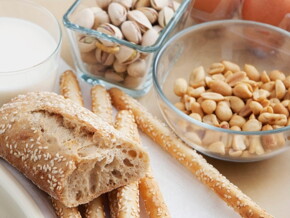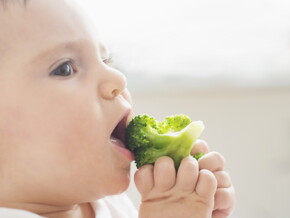
How to provide a healthy toddler diet
How to provide a healthy toddler diet
A healthy toddler diet now can set your little one up for a lifetime of healthy eating. Here are some nutrition building blocks for the best food for toddlers.
- Choose foods with little or no added salt or sugar
- Offer a variety of foods, generally following the advice in Canada’s Food Guide.
- Remember that toddler-sized servings are much smaller than adults’. A serving of bread for a one to two-year-old is around half a slice, and a serving of meat is around 30g (1oz)—that’s about a third of your palm.
- A regular routine of meals and snacks will help you and your toddler.
- Give your toddler more food if he shows you that he’s hungry. Just don’t overload his plate with too much at the start.
- Serve foods in appropriate sizes and texture—whole carrots and whole grapes are potential choking hazards. Carrots should be cooked soft and cut into bite-sized pieces and grapes should be cut up in half lengthwise.
- Growing minds and bodies use up their reserves quickly. Keep your toddler topped up with a routine that includes healthy snacks.
- Health Canada recommends continued breastfeeding for older infants and children. If you are not breastfeeding, choose pasteurized, homogenized (3.25% M.F.) cow milk as your child’s main milk source starting between 9 and 12 months when they are eating a variety of iron-rich foods..
- Limit juice and sweetened beverages and give your child water instead. Young children have small tummies and fill up quickly on beverages.
- Continue your child’s vitamin D supplement if they are still drinking breast milk.
- If you think you’ve got a picky eater, read our checklist on how to help
Sources
Health Canada, Canadian Paediatric Society, Dietitians of Canada, & Breastfeeding Committee for Canada (2014) Nutrition for healthy term infants: Recommendations from six to 24 months. Accessed September 2020.
Related articles

What to consider when choosing a daycare
Wondering how to pick a daycare to look after your baby? We have put together a list of some things to consider when choosing a daycare, from childcare costs to location.
2 mins to read

A guide to family meals for toddlers
Wondering how you can enjoy family meals for toddlers? Eating together is a lovely way to bring everyone together and to teach your toddler about healthy eating.
2 mins to read

Baby food allergies Vs intolerances—things to consider
Baby allergies and intolerances can develop at any time. An allergy is our immune system’s reaction to a substance it thinks is harmful.
3 mins to read

Coping with separation anxiety in babies and toddlers
Separation anxiety in toddlers is a normal and healthy part of development though it can be upsetting for you and your baby. Here are some tips to help you both cope with separation anxiety.
1 min to read

Potty training : When to start
No matter how eager you may be there is no "right" age to start potty training your little one.
4 mins to read

How to encourage baby’s first steps—in 10 steps
It can be exciting to watch your baby’s first steps—or at least, attempted steps.
2 mins to read

Planet-saving tips for an eco-friendly baby
Saving the planet doesn’t have to stop because you’ve had a baby. Yes, they’re a teeny bundle of mess-creating, gadget-needing joy.
2 mins to read

Tips for potty training toddlers
Wondering how to potty train or when to start potty training? Read our potty-training tips and tricks to help toddlers hit the spot.
2 mins to read

Toddler meals ideas | Nutrition and Feeding for Your Growing Toddler
By one year of age, your little one should be eating a variety of foods from the four food groups in Canada's Food Guide. He’s likely discovering new tastes, textures and skills.
9 mins to read

Baby talk: How to encourage baby’s first words.
Your baby’s first words are likely to happen after a few months of baby talk.
2 mins to read

How to handle toddler sleep problems
You know they’re tired, but they refuse to listen—and try as you will, the land of nod seems but a distant dream.
2 mins to read

Children’s dental care checklist
Looking after our teeth is a lifelong undertaking so it helps to get off to a good start.
2 mins to read

Exercise with toddlers: Clever mom hacks for hectic lives
Some days, the last thing you probably feel like doing is exercise—particularly if you’ve had a sleepless night. But keeping active can do wonders for your physical and mental health.
2 mins to read

Terrible twos coming up? How to deal with toddler tantrums
Now they’re walking and talking, your toddler’s asserting their independence more and more every day, as well as developing a strong willpower!
2 mins to read

How to help a picky eater
Wondering how to help a picky eater? Developing a palate takes time. So we’ve prepared a menu of useful tips to help turn your picky eater into a food lover.
1 min to read

Working mom woes? Follow our tips for going back to work after a baby
If you’ve decided to go back to work and are preparing to become a working mom, you’re more than likely navigating a rollercoaster of emotions.
3 mins to read

Tips on planning a toddler birthday party
Planning a one-year-old’s birthday party can be surprisingly tricky.
3 mins to read

How to help toddler tummy problems
Painful toddler tummy problems, including toddler diarrhea and toddler constipation, are horrible for parents and babies alike.
2 mins to read

Storing baby cereals: Freshness & Safety First!
You want to serve your little foodie the best in infant nutrition. What you don’t want are bugs in her food—yuck!
2 mins to read
Related tools
Article finder
Expert articles and tips about development, parenting support, and nutrition


